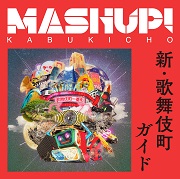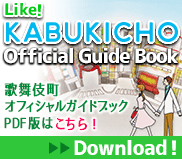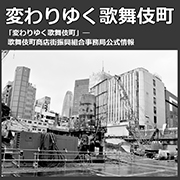Yearly Schedule
Hanazono Shrine's Annual Festivals
 The highlight festival would be the Shinko festival, which features two portable shrines.
The highlight festival would be the Shinko festival, which features two portable shrines.The Shinko festival is held on the Saturday, Sunday, and Monday closest to May 28th.
Present day Kabukicho 1-chome used to be a area called Tsunohazu, where Kumano shrine
now rests. 2-chome used to be the Nishi Okubo area, where Kio shrine now rests.
The Golden Gai area used to be Sanko town, where Hanazono shrine now rests. Each shrine has its own original festival, making for big Kabukicho attractions.
Shinjuku Eisa Festival Shinjuku's Hottest Day
 The annual mid-summer traditional festival.
The annual mid-summer traditional festival. Eisa represents the tradition of Okinawa.
At the festival, participants shout with passion. Held on the last Saturday of July.
Shinjuku Golden Gai Thanksgiving Festival
 Held on the last Sunday of August, no entry fee is required and all drinks are only ¥500.
Held on the last Sunday of August, no entry fee is required and all drinks are only ¥500.Golden Gai is normally a place to enjoy conversation with the other customers, but being packed with so many people around festival time, you can just try and Find a bar that you want to visit again when things quiet down.
Shinjuku Junisha - Kumano Shrine's Annual Festival
 The district previously known as Tsunohazu spans from Shinjuku Station's west to east exits (and even as far as Kabukicho).
The district previously known as Tsunohazu spans from Shinjuku Station's west to east exits (and even as far as Kabukicho).Shinjuku Junisha: Kumano Shrine is in this area.
The Kumano Shrine's very difficult, and traditional way of carrying their portable shrine is called "Chidori Katsugi", which has an important culture heritage.
Both "Chidori Katsugi" and "Yotsuya Katsugi" (of Suga Shrine, Shinjuku Suga) are very unique styles.
The word "chidori" means a drunkard's walk. "Chidori Katsugi" however, is a bit different, in that they walk with sliding feet.
Yan festival, once every 3 years.
Yin festival, twice every 3 years.
Junisha Kumano shrine's annual festival has a 3-year-cycle.
In the Yan festival, 2 big portable shrines (1.5t each) parade around Shinjuku station. In the Yin festival, each area's portable shrine parade around Shinjuku and other towns, the shrine associations unite, and a handful of portable shrines parade around Shinjuku station. The parade's dynamic views are a pleasure to see.
The Shinjuku Hanazono Shrine Otori Festival
 This event houses approximately 60 shops selling decorative rakes, and approximately 200 stands selling food and drink both within and without the grounds.
This event houses approximately 60 shops selling decorative rakes, and approximately 200 stands selling food and drink both within and without the grounds.The Tori no Ichi at Hanazono Shrine is visited by 600,000 people every year, and has been going on since the Meiji Period.
The decorative rakes are to promote good business, and are sold at stands calling out with lively voices, are an irreplaceable symbol for the city as it enters December.
(The photo on the right shows the chief priest, Yuji Katayama, who took photos of the Tori no Ichi himself.)
Kio Shrine's Annual Festival
 Kabukicho's 2-chome; where Kio shrine is built, is the territory of shrine carers.
Kabukicho's 2-chome; where Kio shrine is built, is the territory of shrine carers. Kio Shrine is the only shrine where demons are said to grace your skin disease, and many other ailments. The god Ebisu; enshrined in Mishima Shrine, is one of the 7 Shinjuku Yamanote gods. Its annual festival is held every September.
A portable shrine with two sculpted demon faces liven up the festival.





























